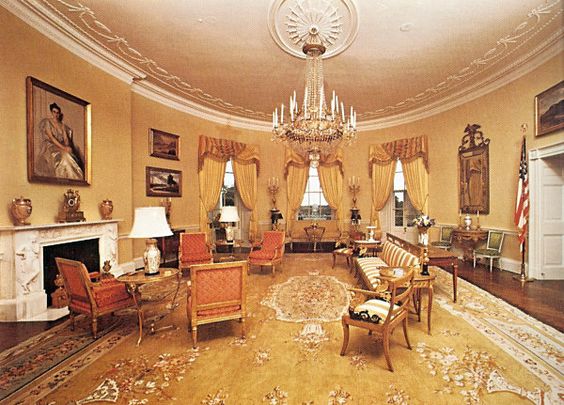1977: Carter Administration

Carpet description:
- Oushak Anatolia rug
- Classic Turkish design
- Very in-demand style
The Yellow Oval Room is located on the second floor in the White House. First used as a drawing room during the John Adams administration, it was often previously used as a library, office, and family parlor. It was in this room on December 7, 1941 that Franklin D. Roosevelt learned of the Japanese attack on Pearl Harbor. The Secret Service moved his desk away from the windows as a security precaution. Today, the Yellow Oval Room is used for small receptions and receiving heads of states immediately before a State Dinner. During the Kennedy Administration, the room was designated as a drawing room and received many of the furnishings that still remain, as well as its designation as the Yellow Oval Room. American interior designer Sister Parish established the basic design of the room by painting the walls a soft yellow, joined by a pale yellow oval carpet topped by Oriental rugs. Now an Anatolian Oushak carpet, the room contained an oval, robin's egg blue oval carpet in the Woodrow Wilson era.
The Yellow Oval Room room was refurbished in the 1970s under the direction of Pat Nixon. It was redesigned in a more academic style by the Nixon's new curator, Clement Conger, with architect and interior designer Edward Vason Jones. Vason Jones replaced Sister Parish's simple curtains that fit within the window frames with the current, grander gold and coral stripe that cover the woodwork, somewhat reducing the sense of height of the room. A settee and two matching chairs, crafted for President James Monroe in 1805, were donated by a Houston, Texas, resident. A Turkish Hereke carpet and four French bergère armchairs were also added to the room.
History of Oushak rugs
Oushaks are Turkish carpets named after the city of Uşak, Turkey, which was a major center of rug production from the early days of the Ottoman Empire right up to the early 20th century. Historically, Oushaks were classified as "Anatolian", meaning "land of the rising sun". The term "Anatolian" is only used when a more specific identification cannot be found; at which point it simply refers to a carpet made in Turkey.
The level of international popularity attained by Ushak carpets was great and the region of Uşak remains a vibrant center of hand-made carpet weaving today. They are some of the finest oriental rugs, with many of the masterpieces of the 15th and 16th centuries, as well as the popular star and medallion style carpets, attributed to Oushak. Oushak rugs are known for the silky, luminous wool they work with. The dyes tend toward cinnamons, terracotta, gold, blue, green, ivory, saffron and gray tints.
In the European markets, the earlier types of Turkish carpets, before the "star" type, are called "Lotto" and "Holbein" carpets, named after the painters who painted tableaus in minute details that were placed to brighten the background. They came to imply wealth and status. These rugs were imported by Europeans, where they adorned cathedrals, churches, and the homes of the wealthy and powerful.
The late 17th century saw a decline in the Oriental rug market as European consumers tended to purchase rugs of European origin - primarily Aubusson, Savonnerie and Axminster. The wane in the European market meant that Oushak production declined, with most being manufactured for upper-class people in the Turkish territories of Eastern Europe the late 18th and early 19th centuries. Towards the end of the 19th century, when the European market began to be interested in Persian carpets once again, the Oushak population did not have enough weavers still skilled in the traditional Oushak craft. Manufactories had to turn to neighboring villages and their craftsmen who still maintained traditional techniques. Therefore, weavers came from villages outside of Oushak and employed tribal techniques.
At this time, the new Oushak industry saw two major shifts in design: floral patterns in the Persian tradition were incorporated and decorative carpets were woven as European standards demanded. The use of larger knots and an all-wool foundation became widespread. The tribal style fused with the older Oushak/Smyra designs. The merger of the two styles created a new style simply known as late 19th/early 20th century Oushak carpets. The new decorative Oushak, commercially woven, employed a soft red, its primary color offsetting the large-scale floral motifs from the field in a bright blue. The luxurious quality of the wool aided the colors luminosity.
Sources and inspiration: Bérinstain, Valérie, et al. L'art du tapis dans le monde (The art of carpets in the world). Paris: Mengès, 1996. Print.; Jerrehian Jr., Aram K.A. Oriental Rug Primer. Philadelphia: Running Press, 1980. Print.; Herbert, Janice Summers. Oriental Rugs, New York: Macmillan, 1982. Print.; Hackmack, Adolf. Chinese Carpets and Rugs, Rutland and Tokyo: Tuttle, 1980. Print. ; De Moubray, Amicia, and David Black. Carpets for the home, London: Laurence King Publishing, 1999. Print.; Jacobsen, Charles. Oriental Rugs A Complete Guide, Rutland and Tokyo: Tuttle, 1962. Print.; Bashir, S. (n.d.). Personal interview.; Web site sources and dates of consultation vary (to be confirmed). Without prejudice to official usage.
Place an Order
We can reproduce any carpet shown on this page in the size and colors of your choice. For more information or to place an order, call us at +1-514-735-1958 from Monday to Saturday between 10 am and 5 pm Eastern standard time or feel free to e-mail us at [email protected]


 Tapis d'Orient Bashir | Bashir Persian Rugs
Tapis d'Orient Bashir | Bashir Persian Rugs
 @tapisbashir
@tapisbashir
 @bashircarpets
@bashircarpets
 @bashircarpets
@bashircarpets